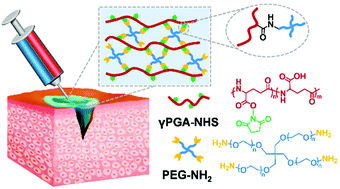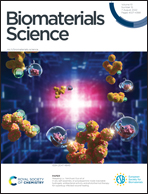In situ forming injectable γ-poly(glutamic acid)/PEG adhesive hydrogels for hemorrhage control†
Abstract
Rapidly in situ forming adhesive hydrogels are promising candidates for efficient hemostasis due to their easy administration and minimal invasion. However, development of biocompatible and high-performance hemostatic hydrogels without any additional toxic agents remains a challenge. Herein, a series of novel injectable adhesive hydrogels based on N-hydroxysuccinimide (NHS) modified γ-poly(glutamic acid) (γPGA–NHS) and tetra-armed poly(ethylene glycol) amine (Tetra-PEG-NH2) were developed. Among all samples, PGA10–PEG15 and PGA10–PEG20 hydrogels with higher PEG contents exhibited rapid gelation time (<20 s), strong mechanical strength (compression modulus up to ∼75 kPa), good adhesive properties (∼15 kPa), and satisfactory burst pressure (∼18–20 kPa). As a result, PGA10–PEG15 and PGA10–PEG20 hydrogels showed a remarkable reduction in hemostasis time and blood loss compared with gauze and fibrin glue. More importantly, the PGA10–PEG20 hydrogel was also successfully used to seal femoral arterial trauma. Subcutaneous implantation experiments indicated a good biocompatibility of the hydrogels in vivo. All these results strongly support that the developed PGA–PEG hydrogels could serve as promising hemostatic agents in emergency and clinical situations.

- This article is part of the themed collection: Biomaterials Science Recent HOT Articles


 Please wait while we load your content...
Please wait while we load your content...